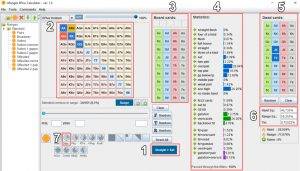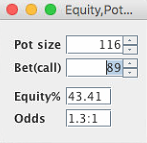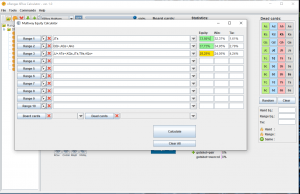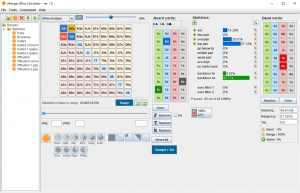Using Oranges 6Plus to improve your game: Part One
- Dec 19, 2019
- [email protected]
- In Deals, Strategy
This article will show you how to use Oranges 6Plus Calculator to study the game of 6+ Hold’em / Short Deck. It’s currently the best and most advanced equity tool for the game, and comes at a price of $50. If you are familiar with tools like Flopzilla and Pro Poker Tools, you should have some understanding of how to use an equity calculator, but in this article we will start from the very basics and move on to more advanced features.
For simple hand vs hand or range vs range we do offer a free and mobile-friendly web-based equity calculator here.
Basic Hand Analysis: Facing 3-bet All-in
This first example will show you how to do a pretty basic example together with explanations of the primary user interface.
In the screenshot below you’ll see all the relevant areas to do hand analysis for a majority of situations. If you were only to use this functionality, Oranges Calculator would still be worth it’s price, but it offers much more advanced features, which we will cover in future articles.
Let’s do an example where we raise to 10 antes in the HJ with J♦T♦ after UTG limped, and now UTG shoves all-in for a total of 100a.

#1 First thing is to be sure ‘Straights > Set’ is turned on, otherwise you’ll get results for the wrong game type.
#2 Select the range you think your opponent might have. Here we have selected a tight 3-bet range of AA, KK, QQ, AKs and AKo. If you would like to add weighting to a hand, so let’s say we want to add that opponent would also 3-bet 50% with T9s turn on the slider above the hand matrix and adjust the slider to 50%. Now click on T9s and it will be weighed at 50% in the calculation.
#3 Add the desired board. Our example here is pre-flop, so no board cards.
#4 This shows statistics for how often the selected hand range hits made hands, and also potential draws or draw + made hand. It’s not very relevant in this hand example, but the statistics can be used to learn valuable frequencies. E.g. that a suited hand will flop a flush draw 9.5% of the time or JT will flop an open-ended straight draw 19% of the time.
#5 In ‘dead cards’ we choose our hand J♦T♦.
#6 Our calculated result. We see our hand has 40.7% equity.
#7 Oranges 6+ comes with an easy to use pot odds calculator. In our hand example there’s 17a in dead money plus 99a that opponent shoves. We have 89a in our stack remaining to potentially call the all-in.

So all in all we would need 43.4% equity against our opponents range to be break-even. ~42% after rake is considered.
Against the the 3-betting range of AA, KK, QQ, AKs and AKo we got just 40.7%, so it would be minus EV to call in this example.
If we give our opponent a slightly wider range, as seen below, we get 42.7%, so against this range we are about break-even.

Against a wide 3-betting range (~13%), as seen below, we get 44.4% equity. Needing 42% with rake considered calling is +EV.

Multi-way equity: Calling all-in from two opponents
In this next example we’ll need to calculate multi-way equity. For this, go to Tools -> multi-way equity calculator.
Players are 100a deep – 6 handed. Action goes as followed:
Villain (MP) opens to 10a
Hero (HJ) calls 10a with J♦T♦
Villain (BTN) raises all-in for 100a
Villain (MP) calls all-in.
Hero?
There is 7a + Hero’s 10a in dead money in the pot. Villain (MP) and Villain (BTN) all-ins count for 99a and 98a respectively.
Hero needs to call 89a into 214a, which means 29.3% equity is needed for a break-even call and ~28% after rake is considered.
For Villain (MP) we set a range of JJ+, ATs+, KQs, JTs, T9s and AQo+.
For Villain (BTN), who overcalls all-in, we will set a tighter range of QQ+, AQs and AKo.
In the screenshot below you can see the multi-way calculation. JTs has ~34% equity, so this is significantly +EV call.

Please note that the odds calculator on our site can do the same multi-way calculation, using the same range syntax.
Calling all-in on the flop with a straight draw
Let’s look at an post-flop example, played on PokerStars $2 ante. Action goes as followed:
MP limps
Villain in HJ raises to $26 ($270 stack)
Hero calls 13a in CO with T♥9♥ (covers Villain)
MP folds
Flop is: K♦7♣8♠
Pot is $68
Villain goes all-in for $244
Hero?
We need to call $244 into a pot of $312, which means we need 44% equity for a break-even call.
In the screenshot below we set Villains range to be AA, AKs, AKo and KK. This gives us ~49% equity and the call would be +EV.

Pre-flop All-in Helper
The last thing we will cover in this first part about Oranges 6+ is the Pre-flop All-in Helper. This tool is useful for 6+, because there usually is a lot of pre-flop all-ins and equities run much closer than in NLHE, so the correct call and pushing ranges might not be so obvious.
Let’s try an example where we are playing in a shorter stacked game, like the game format on GGPoker. 5-max table and all players sit with 50a.
The Pre-flop All-in Helper shows you what hands to call with against Villain’s range, so Hero will not be given a specific hand.
It’s folded to Hero in CO, who limps.
Villain on the BTN goes all-in for 50a.
First let’s use the tool with a very tight range for Villain.

We select range in the range matrix and open the Pre-flop All-in Helper in Tools.

In the screenshot we put in that the total pot is 55a (Villain bet 48 and antes count for 6 + Hero limped 1a). Hero has to call 48 (posted one ante and limped one). Hero limped, so ‘Hero Bet’ is set to one.
Not surprisingly, we can see that we should only call with four hands. All others are -EV. Let’s change Villain’s range to something more realistic. It’s easy as you just need to change the range in the ‘range matrix’ in the main window. So let’s widen the range of Villain to something very aggressive (26.3% of hands).

We can just press ‘Pre-flop Call EV’ to update the numbers against this new range. This gives us the following:

This shows us that all hands in green are a +EV call with a total EV of 18.73%. A lot of the hands in this example are close to borderline EV, like KQo, you could choose not to call, as there is always uncertainty in defining ranges for opponents.
oRanges 6plus Trial
You can get a five day trial to use the calculator and start analyzing situations yourself. Simply download (links below) and activate your trial. If you wish to purchase it, we can offer you many methods of payment such as Skrill, PokerStars, GGPoker, BTC, Paypal or Neteller for a price of $60. Just sent us an email and we will assist you with the request: [email protected]
2 Comments
Leave a Reply to [email protected] Cancel Reply
Best Deals
Number of items in cart: 0
- Your cart is empty.
- Total: $0.00
- Checkout










“So all in all we would need 43.4% equity against our opponents range to be break-even. ~42% after rake is considered.”
Wait, shouldnt rake make needed equity bigger? I mean, we need better hand, as we need to win more money, to cover rake.
Yes, it’s a mistake. Fixing it